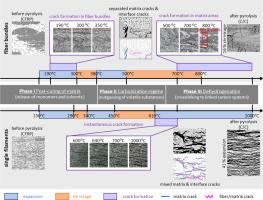制备陶瓷基复合材料(CMC)的湿法无纺布基CFRP热解过程中的微观结构发展
IF 2.8
Q1 MATERIALS SCIENCE, CERAMICS
引用次数: 0
摘要
纤维增强对陶瓷基复合材料的性能起着至关重要的作用。在各种纺织技术中,湿法非织造布受到了人们的关注,因为先前的研究表明,湿法非织造布的生产方法对液态硅渗透(LSI)过程中陶瓷的形成有显著影响。本研究利用显微技术在小型炉中研究了热解过程中现场显微组织的演变。研究了两种碳纤维增强聚合物(CFRP)类型:单长丝和纤维束湿成非织造布。热分析显示了不同的行为。在单长丝样品中,由于基体弱化和应力释放,在610℃左右发生关键裂纹。相比之下,纤维束样品在150-300°C和700°C以上的温度下,由于放气、基体部分脱落和基体收缩而形成裂纹。这些机制导致了单长丝增强材料的富碳素结构和束增强材料的富碳短纤维复合材料。研究结果支持针对特定应用的CMC特性定制加固设计。本文章由计算机程序翻译,如有差异,请以英文原文为准。

Microstructure development during pyrolysis of wet-laid nonwoven-based CFRP for the manufacturing of ceramic matrix composites (CMC)
Fiber reinforcement plays a critical role in defining the properties of ceramic matrix composites (CMCs). Among various textile technologies, wet-laid nonwovens have gained attention because previous studies have shown that their method of production significantly influences ceramic formation during liquid silicon infiltration (LSI) [1]. This study investigates in-situ microstructural evolution during pyrolysis using microscopy in a small-scale furnace. Two carbon fiber-reinforced polymer (CFRP) types were examined: single filament and fiber bundle wet-laid nonwovens. Thermal analysis revealed distinct behaviors. In single filament samples, key cracking occurred around 610 °C due to matrix weakening and stress release. In contrast, fiber bundle samples showed crack formation at 150–300 °C and above 700 °C, driven by outgassing, partial matrix detachment, and matrix shrinkage. These mechanisms result in SiC-rich structures for single filament reinforced materials and carbon-rich, short fiber composites for bundle reinforced materials. The findings support tailored reinforcement design for application-specific CMC properties.
求助全文
通过发布文献求助,成功后即可免费获取论文全文。
去求助
来源期刊

Open Ceramics
Materials Science-Materials Chemistry
CiteScore
4.20
自引率
0.00%
发文量
102
审稿时长
67 days
 求助内容:
求助内容: 应助结果提醒方式:
应助结果提醒方式:


